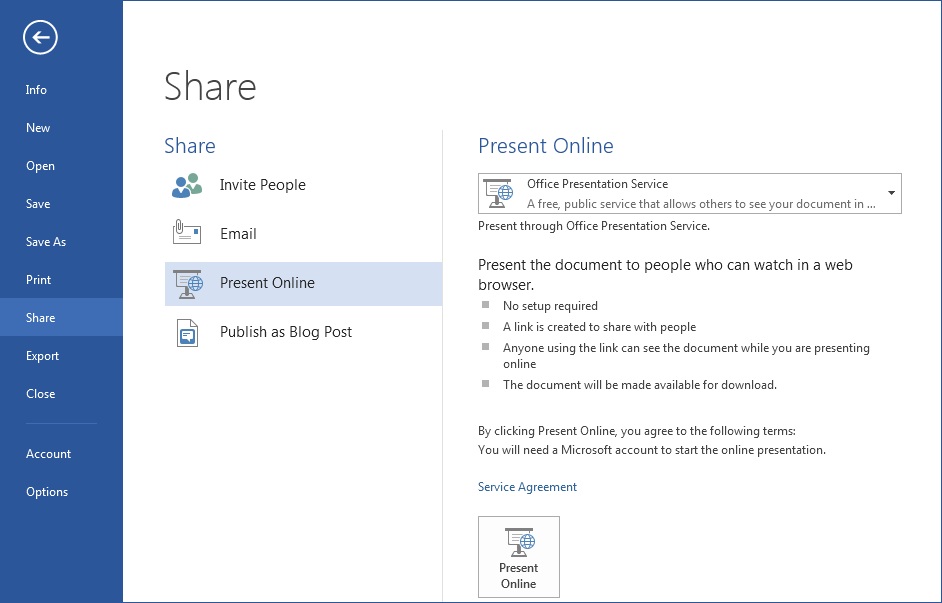Redefining Collaboration: A Comprehensive Guide to Presenting Documents Online in Microsoft Word 2013

Introduction:
In the fast-paced world of modern collaboration, the ability to present documents online has become a cornerstone of effective communication and teamwork. Microsoft Word 2013 introduces a range of features that empower users to seamlessly share and present their documents in real-time. This comprehensive article delves into the intricacies of presenting documents online within the Word 2013 environment, unraveling the tools, features, and best practices that redefine the collaborative landscape.
Real-Time Collaboration with OneDrive:
At the forefront of online document presentation in Microsoft Word 2013 is the integration with OneDrive, Microsoft’s cloud storage service. Users can effortlessly save their Word documents to OneDrive, enabling real-time collaboration and access from any device with an internet connection. This cloud-based approach fosters a dynamic environment where users can present, edit, and collaborate on documents simultaneously.
Initiating Online Presentations:
To initiate an online presentation in Microsoft Word 2013, users can follow a straightforward process. With the document open, users navigate to the “File” tab and select the “Share” option. From here, the “Present Online” feature comes into play, allowing users to start a presentation that can be accessed by collaborators in real-time. This feature eliminates the need for cumbersome file-sharing methods and streamlines the presentation process.
Customizing Presentation Settings:
Microsoft Word 2013’s online presentation feature is designed with customization in mind. Before initiating the presentation, users can customize settings to tailor the online experience to their specific needs. This includes options to allow or restrict editing by collaborators, controlling the pace of the presentation, and even setting a password for additional security. These customization options empower users to create a presentation environment that aligns with their goals and preferences.
Inviting Collaborators:
Collaboration is at the heart of online document presentation in Microsoft Word 2013. Once the presentation is initiated, users can invite collaborators by generating a unique sharing link. Collaborators can access the document by clicking the provided link, enabling them to join the presentation in real-time. This collaborative environment is ideal for team meetings, brainstorming sessions, and any scenario where multiple stakeholders need to review and contribute to the document simultaneously.
Real-Time Editing and Commenting:
The online presentation feature in Microsoft Word 2013 goes beyond passive viewing; it enables real-time editing and commenting. Collaborators can make edits to the document, and these changes are immediately reflected for all participants. The ability to leave comments enhances communication, allowing collaborators to provide feedback, ask questions, and engage in a dynamic discussion without interrupting the flow of the presentation.
Chat Functionality for Instant Communication:
In the spirit of seamless collaboration, Microsoft Word 2013’s online presentation feature includes a chat functionality. Collaborators can engage in real-time conversations within the document, fostering instant communication and collaboration. Whether discussing specific sections of the document or providing clarification on edits, the chat feature enhances the collaborative experience, creating a virtual workspace for effective communication.
Real-Time Presence Awareness:
To elevate the online collaboration experience, Microsoft Word 2013 incorporates real-time presence awareness. Collaborators can see who else is actively viewing or editing the document, providing transparency and awareness of ongoing activities. This feature enhances coordination among collaborators, preventing conflicting edits and promoting a cohesive and synchronized workflow.
Recording and Playback:
Recognizing the importance of accessibility, Microsoft Word 2013’s online presentation feature includes a recording and playback option. Users can record the entire online presentation, capturing not only the document changes but also the collaborative discussions and chat interactions. This recording can be shared with participants who may have missed the live presentation, ensuring that everyone is on the same page.
Offline Access with Automatic Synchronization:
While the emphasis is on real-time collaboration, Microsoft Word 2013 ensures that users have the flexibility to work offline. Any edits made offline are automatically synchronized when the user reconnects to the internet. This seamless transition between online and offline modes enhances the user experience, providing flexibility without compromising collaboration.
Integration with Microsoft Teams:
For users leveraging Microsoft Teams as their collaborative hub, the online presentation feature in Microsoft Word 2013 integrates seamlessly. Users can initiate presentations directly from Microsoft Teams, fostering a unified collaboration experience. This integration streamlines workflows for teams that rely on Microsoft Teams for communication, file sharing, and project management.
Security and Permissions:
In the ever-evolving landscape of online collaboration, security is a paramount concern. Microsoft Word 2013’s online presentation feature addresses this by incorporating robust security measures. Users have granular control over permissions, allowing them to determine who can view or edit the document during the presentation. Additionally, password protection adds an extra layer of security for sensitive presentations.
Accessibility Across Devices:
As the digital landscape becomes increasingly diverse, Microsoft Word 2013’s online presentation feature ensures accessibility across various devices. Whether collaborators are using desktop computers, laptops, tablets, or smartphones, the online presentation adapts to different screen sizes and device specifications. This device-agnostic approach promotes collaboration without restrictions, accommodating the diverse preferences of users.
Conclusion:
In the age of dynamic collaboration, Microsoft Word 2013’s online presentation feature stands as a testament to innovation and user-centric design. From real-time collaboration with OneDrive to customizable presentation settings, this feature redefines how users share, present, and collaborate on documents. The integration of real-time editing, chat functionality, and recording options creates a virtual workspace where collaborators can seamlessly engage with the document content and each other. Microsoft Word 2013’s commitment to security, accessibility, and flexibility positions the online presentation feature as a transformative tool for modern collaboration. Welcome to the future of document presentation, where Microsoft Word 2013 invites you to redefine collaboration in the digital realm.




